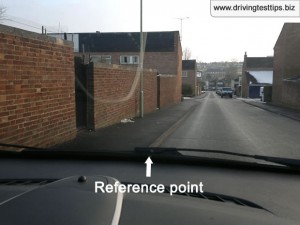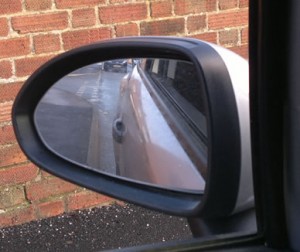During a practical driving test, the requirement is the examiner asking you to park up on the left parallel to the pavement on many occasions.
Among other things, the driving test is to establish to the examiner that you have the ability to park up, next to a kerb (or ‘curb’ as it’s spelled in other areas) in a safe, convenient and legal position (SCALP) and generally ensure that you are not a danger to pedestrians and other road users.
This tutorial will explain exactly what the examiner is looking for when it comes to pulling up on the left, actions to avoid and if as a learner you struggle with parking up, reference points are provided to make parking up on the left side that much easier.
Safe convenient and legal position
When the examiner requests that you park up, they will expect this to be in a safe location. The examiner will not trick you by asking that you park in an area that is illegal and will fail a driving test. You will also only be asked to park on the left side and not the right. You must however ensure that you park a reasonable distance from the kerb (no more than 12 inches).
You can park as close to the kerb as you wish, providing you do not hit it. Ensure you do not park on a sharp bend, too close to a junction that is on your side of the road or opposite a junction.
Parking too close to junctions
Try and park at least 10 metres or more away from a junction if there is one on your side of the road. Parking too close to a junction reduces effective observation for vehicles exiting the junction and can make access difficult for emergency vehicles, especially fire engines.
Parking too close or opposite a junction that is on the right hand side of the road is hazardous for vehicles exiting that junction. If a vehicle is exiting this junction and wishing to turn left, their main observation will be to their right. A vehicle that is driving around you will be on the right hand side of the road heading directly into the path of the vehicle exiting the junction.
Dropped kerb parking
Parking across a dropped kerb which gives access to property should be avoided. Dropped kerb for use of pedestrians to aid crossing roads should also be avoided.

Parking reference points
If you struggle to obtain a good distance away from the kerb when parking, use some reference points to help. This image shows a car that is parked appropriately at around 6-8 inches from the kerb. Through the front windscreen you can see the kerb. As it enters the car, make a reference to that point. This can be referenced with a sticker or mark of some kind.
In normal driving, you will be further right into the road, making the kerb further left than this reference point. When you wish to park next to the kerb use this reference point to slowly edge over closer to the kerb until the reference point lines up.

Second kerbside reference point
Additionally, a second parking reference point should be used to establish how far from the kerb you are and how parallel to the kerb your car is.
When you have a good parking position. make a mental note of what it looks like in your left mirror. It should look something similar to this image. Make a note of the distance from the kerb and how parallel it looks. Whilst parking, use the above reference point combined with this one. It’s important that you edge over towards the kerb in gradual segments. turning too harshly will likely make you hit the kerb with the front wheel.
Park legally
When the examiner requests that you park up, it doesn’t mean that is has to be that instant. They are simply looking that you do so safely. Take your time (within reason) to look well ahead for a good place to park. As previously mentioned, the examiner will not trick you into parking in a prohibited area, although if you take a long time in deciding where to park, you may enter an area that is prohibited to park.
Ensure you do not park on the pavement as this is an instant test failure, keep a keen eye out for signs that prohibit parking and of course double yellow lines. Roadside parking close to the kerb is featured heavily during driving tests from all test centres. Correct kerb side parking keeping safe, in-control and accurate takes time for all learners to master.
It should be practiced constantly whilst learning to drive until a high level of proficiency is obtained. Driving test can and often do involve parking up in busy and stressful situations. If you are confident in your ability to park correctly, you will feel less stressed and stand a higher chance of passing.
Hitting the kerb
If you happen to hit the kerb during a driving test, it depends on the severity and what you were doing at the time that will determine the outcome. Hitting the kerb certainly won’t always result in a failure.
- Read the guide on how to deal with hitting a kerb in the driving test for further information.
Procedure for parking next to kerb
When the examiner requests that they would like you to pull up on the left, immediately take a look into your rear view mirror. Not so you can park, but so you know exactly what is going on around you. If there are no vehicles behind you, slow down a little to make the process easier.
Looking well ahead up the road, locate a safe, convenient and legal parking position. Once you have located a suitable position, you will need to initiate the MSM (mirror, signal, manoeuvre) routine. Look into your rear view mirror, then your left mirror and signal to the left.
Cover the brake and the clutch (place your foot over the pedals but do not press). This will slow the car down and your feet will be in position ready to stop. Gradually ease over to the left using the reference points on this page to gain a suitable distance from the kerb. Gently apply the brake and around 4 or 5 metres from where you intend on stopping, press the clutch so as you don’t stall the car. Once stopped, apply the handbrake, select neutral, cancel the indicator and remove feet from pedals.
Incorrectly parked
Once you have stopped, review your reference points and if you feel that you are too far into the road, explain this to the examiner and tell them you wish to correct this. The fact that you have acknowledged this may prompt the examiner to tell you not to worry. If your car is incorrectly parked, simply not acknowledging this to the examiner and offering to correct may fail the driving test.

Hi there, please help me! I use reference points but just don’t know how to steer to pull up on the left! My driving instructor says that I steer left and move slowly towards the kerb, then I turn right to straighten my car but don’t straighten quick enough. What can I do to avoid this!!!
Hello Heli,
What you need to do is find a very quiet, straight road with a kerb – your instructor can help with that. Use your left mirror to judge the distance you are from the kerb. With your instructors help, park up on the left in a suitable position . Now lower your left mirror enough so that you can see the kerb and the side of your car (but still see down the road) and take a mental ‘snapshot’ of this. Now practice pulling up on the left. When steering left to get close to the kerb, do it in increments – so a little left then straight, left then straight etc until you see that snapshot of the left mirror then straighten the wheel and stop. Avoid steering continuously to the left to park as this is difficult initially and may result in you hitting the kerb. When parking, sit up as high as you can to enable the best view of the kerb and your car as possible in your mirror. Keep repeating this until you get more confident. Then when you get confident, you can do it in one go which seems to be the way your instructor is telling you to do.
Hi thanks for this, but will I fail if i go left then straight in increments on the test? My test is coming up in 2 days and I just can’t get pulling up on the left right in the car I am using (usually I am okay)
This technique is usually used at the start of learning to gradually get over to the kerb in stages rather than one big lunge which increases the risk of hitting the kerb. Try this technique and put in plenty of practice over the next two days to perfect it. Examiners are quite strict when it comes to parking up, but providing you don’t hit the kerb or end up too far away from it, you’ll be fine. But practice is important as you’ll get more confident at doing it.
Thanks a lot, so how do I steer? Like what direction? and how much do I steer into road if I am not going very steeply across but gradually from the lane to the kerb? And what speed should I be using? Sorry for all the questions
Do what your instructor taught you in terms of speed – the slower you do it, the easier it is, but only slow down after you have checked mirrors and indicated. Check mirrors, signal to the left, then steer slightly to the left and as you get closer to the kerb straighten up. Then increments of around quarter of a turn of the wheel, straighten up, turn again etc until you see the correct distance in your left mirror. Once you do, straighten the wheel and stop.
Hi
I failed my test yesterday..
Examiner asked me to pull up on the left hand side behind the silver car and asked me to ignore drive way..
There was not much space to park and due to pavement across drive way I couldn’t park properly..I failed my test for this mistake..
Hi is pulling over at a double yellow line when asked to a fail?
Hi Lana,
Bit of an odd thing for an examiner to ask as during a test, there really wouldn’t be much need for it. However, you can stop on double yellow lines, but you can’t wait. So for example, you can stop to let a passenger out, but then you must move off right away.
Hi josh i am retired Airline pilots with over 20000 hours of flight time to my log book
been driving all over the world encloding UK > My licence issued from USA compiened
by international licence since my retiredment settel her in the UK i went for Drivng test
unfotenally did not passed me > examner failed me mainly by been too slow
i am just choked in 30 mile zone with cars parked on both side of the road how in Gods name expect me to do so << while my goal is been safety just incase cats or Dogs run out infront < i dont belive thats was fair at all
sorry i am so despointed .